|
View Agra City in a larger map |
A Trip to Agra to see the Taj Mahal
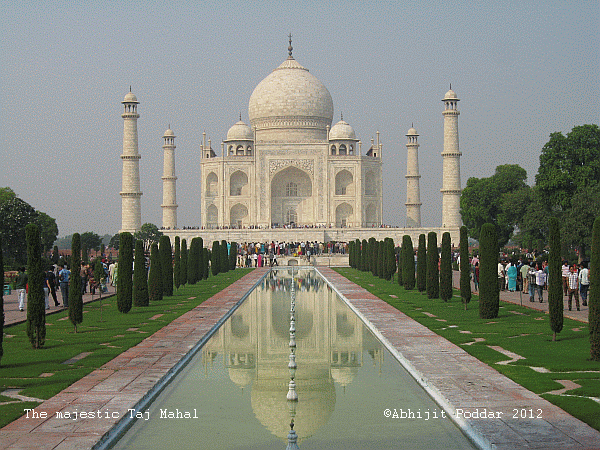
Once our short trip to Delhi was over, we embarked on our journey to Agra to see the Taj Mahal. The journey was rather forgettable. Having failed to get reserved tickets on any of the daily running trains, we ended up boarding a rickety bus at the filthy ISBT bus terminus at Kashmiri Gate, on the outskirts of Delhi. We were told that it would take around four hours to reach Agra but a good three hours into the journey we realized it would take us much longer. All this while my wife had not spoken a word and the scowl on her face seemed to be getting bigger with each passing minute when suddenly, the bus made an unscheduled stop at a roadside dhaba (eatery). A few gulps of fresh lassi (sherbet made with lime and yoghurt) and the fresh breeze from the countryside helped drive away the creases on her forehead and saved our trip from becoming a nonstarter.
Once we reached Agra, a rikshaw-walla helped us locate a hotel at a decent price. Although the hotel was big and spacious, we felt it had seen better days. It had a great restaurant though, serving delicious Mughlai and Chinese cuisine. Next morning we took an autorikshaw to the Taj Mahal. On the way we saw the city, old, crowded and not too clean either. The roads however were smooth, and in no time we were at the outer gate of the Taj complex. A rikshaw-wallah accosted us and offered to take us to the main entrance. We would also get to see many shops lining the road selling authentic artifacts related to the Taj Mahal, so he said. We were not in the mood to buy any souvenirs, at least not yet. As we entered the Taj Mahal complex through a side entrance, we had to queue up to buy tickets to enter the inner complex. While Indian tourists had to pay twenty rupees for a ticket, tourists from abroad had to shell out forty times the amount! No wonder I spotted a few tourists miffed at being discriminated in this fashion. The security at the gates was both exhaustive and intrusive, with metal detectors in place and X-ray scans and body frisking being carried out. No food items were allowed inside the premises. A lady constable found a new packet of cookies in my wife's handbag. Hungry as we were, we told her that we would eat the cookies right in front of her. That did not seem to cut any ice, though, as she arrogantly threw the packet into the dustbin.
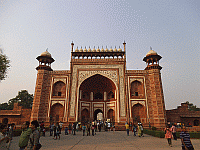
Once inside the inner complex, we came across a huge, limestone colored gate. As we jostled with the crowd to make our way through the gate, we came across a stupendous view of Taj Mahal, draped in magnificent white. Me and my son got busy with our cameras, clicking frantically before being shoved to to the right by others in the crowd. A little in front was a seat for two made of stone, made famous by the most famous people in the world, past and present, who had visited the Taj Mahal and had their pictures taken while sitting on the seat with the Taj providing a magnificent backdrop.
History has it that the Taj Mahal was built by Shah Jahan, the grandson of the legendary Mughal emperor Akbar, in memory of his beloved wife, Mumtaz Mahal. When Mumtaz died, she was buried and a beautiful mausoleum, all of marble, was built over her grave. This monument came to be known as the Taj Mahal. Later on when Shah Jahan died, as per his wish, he too was buried under the structure, just beside the grave of his beloved wife. The structure itself consisted of a huge marble dome, erected over an elevated rectangular platform which had four towers or minarets at its four corners, also made of marble. Though not apparent, the minarets were slightly tilted outwards, we were told, so that they would not fall on the central dome in the event of an earthquake or a big storm.

One had to leave one's shoes behind before climbing the stairs leading to the actual dome. The sheer size and the magnificent architecture of the structure held us spellbound. There were exquisite engravings and colourful paintings adorning the walls of the Mahal. We were told that originally the walls were embellished with gold, gems and precious stones. But the depredations of successive invaders had ensured there were no such embellishments left for us to see. It was very quiet and somber inside the dome itself. Photography was not permitted inside. We then set out to make a round trip of the dome. Interestingly, the Taj Mahal looked exactly the same from all four sides. The symmetry spoke volumes of the proficiency of the architects instrumental in designing the structure. Behind the Taj Mahal flowed the meandering Yamuna River. A group of local people had come down to immerse the idols of their deities following a religious festival. Under the setting sun it was a sight to behold. Further away one could faintly see the Agra Fort which we would be visiting later on.

We spent the next half-an-hour clicking pictures of the Taj from different angles and positions. The monument is so majestically beautiful that even the shots taken by an amateur would turn out to be wonderful, and so they did. Having spent a good couple of hours with the Taj Mahal, we set out on a horse drawn carriage called a Tonga to visit the Agra Fort. Interestingly, only horse or camel drawn carriages and battery operated golf-carts are allowed to ferry tourists in this route, lest polluting motor vehicles destroy the white sheen of the Taj Mahal.
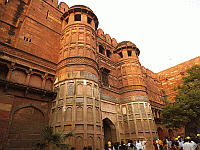
The Agra Fort, though not as grandiose as the Taj, was equally imposing and had a richer history behind it. It was built (some say rebuilt) by Emperor Akbar, and so was much older to the Taj Mahal. It was here that Akbar lived with his wives, one of whom was the beautiful Jodha Bai and ruled the kingdom guided by his trademark moderate and secular views. At the entrance to the fort, we were accosted by a few lads posing to be guides. After some bargaining, we agreed to have one of them guide us through our rendezvous inside the fort. The youngster showed and explained to us the importance of the various parts of the fort. One of them was the Diwan-I-Khas where the emperor, along with his ministers used to hold meetings with the public at large. We also saw the rooms where the emperor's queens stayed. Jodha Bai, we were told, liked to bathe on the bank of the Yamuna river outside the fort. To keep her happy, Akbar had built a secret staircase so that she could leave the fort and come back unnoticed. Our young guide also had an interesting information to share. The blockbuster Bollywood movie, Jodha Akbar, starring Ritwik Roshan and Aishwairya Roy had been shot inside these very premises.
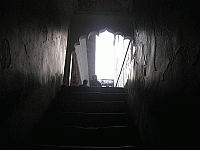
We were also showed a small room on the terrace and told that Aurungzeb, one of Shah Jahan's son's, had imprisoned his father and kept him confined at that very place. Shah Jahan longed to see the Taj Mahal, but his poor eyesight prevented him from doing so. Aurungzeb did him a favour. He had a big diamond stone affixed onto the wall of the room so that his father could see the Taj Mahal's reflection on the stone and be happy. We did not see any diamond but we did see a big hole on the wall. Not that we needed the diamond to see the Taj Mahal. Although quite far, we could see it faintly, basking under the evening sun. It was time to leave the fort. As we walked down the ramp leading to the exit, it was fascinating to know that in those days the steep slope of the ramp helped in rolling down big boulders to thwart invaders who dared attack the fort.
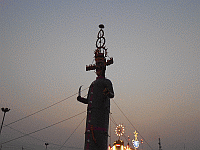
We came out of the fort and were on the look out for an auto-rikshaw to take us back to our hotel, when we noticed a huge effigy of Ravana on the open ground beside the fort. It was Dusshera, the culmination of Ramlila, when characters playing the role of Rama and Lakshman in the mythological epic Ramayana, use their fiery arrows to destroy the effigy of the evil king Ravana and his accomplices, thereby symbolizing the victory of good over evil. Our son wanted to stay and watch the events unfold, but it was getting dark and we had to return and plan for our trip to Fatehpur Sikri the next day.
Fatehpur Sikri, close to Agra, was built by Akbar to commemorate one of his victories and made the capital of the Mughal empire. To reach it, one needed to hire a cab. One could also avail of the bus services of Uttar Pradesh State Transport Corporation and that is what we did the next morning. The road from Agra to Fatehpur Sikri was newly laid out and smooth. The bus was new too and not crowded. We enjoyed the forty minute journey through the picturesque countryside and reached Fatehpur Sikri around noon. One had to enter the actual site through a huge gate known as the Buland Darwaza, but not before climbing a large number of steps. Inside there was an expansive courtyard with beautifully laid out buildings on its sides. One of the buildings was a mosque known as Jama Masjid. The other buildings, we were told, were palaces once adorned with gold and silver.

At the opposite end of the courtyard was the tomb or dargah of the sufi saint Salim Chisti, laid out in marble. We were told that a visit to the Dargah can help fulfill the wishes of couples longing for the birth of their child. The atmosphere inside was quiet and peaceful, with a heavy scent of burning incense-sticks. In front of the Dargah, a person was seated on the courtyard with his harmonium, enthralling the few tourists who had gathered around him with his melodious songs. A few kids suddenly seemed to appear from nowhere and started begging us for some money. One of them started to recite impromptu urdu 'shairies' or couplets while another sang a few Bollywood numbers in the hope that we would relent. Giving the kids money would have meant encouraging begging. Instead, we offered them the whole lot of bananas we had bought outside which they reluctantly accepted.

As we made our exit from the site, we found young lads selling miniature replicas of the Taj Mahal and other show-pieces. We bought a few items, but not before bargaining hard, the prices originally quoted being abysmally high.
The remaining time spent in Agra was uneventful. The city was crowded and unclean. The roads were better though and the food was delicious. We made our plans for our journey to our concluding destination, Haridwar. The best option was to first travel to Delhi and then onto Haridwar. Rail tickets to Delhi were not available and the only option was to travel by bus again. I did not want to repeat my mistake while coming to Agra and incur the wrath of my better half all over again. So I did some googling on my laptop and found that Volvo bus services were available to Delhi from the Idgah Bus stand located at the centre of the city. Next morning we bid adieu to Agra and boarded a plush Volvo bus to Delhi. The bus took the newly laid Yamuna Expressway, a marvellous multi-lane highway resembling the freeways of America. In a matter of two and a half hours we had reached Delhi. Our trip to Haridwar was to follow.
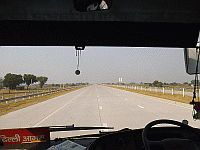
See you all in Haridwar....
P.S. As before all the photographs above have been taken by me or my son using our Canon and Fuji digital point and shoot cameras. I have optimised the images for the web using IrfanView.
Did you like my travelogue? If you did, let me know through my guestbook: www.apoddar.123guestbook.com
Abhijit Poddar
Dept. of Electronic Sc.
Surendranath Evening College
24/2 Mahatma Gandhi Road
Kolkata 700009
email: abhipod at gmail dot com
© Abhijit Poddar All rights reserved.